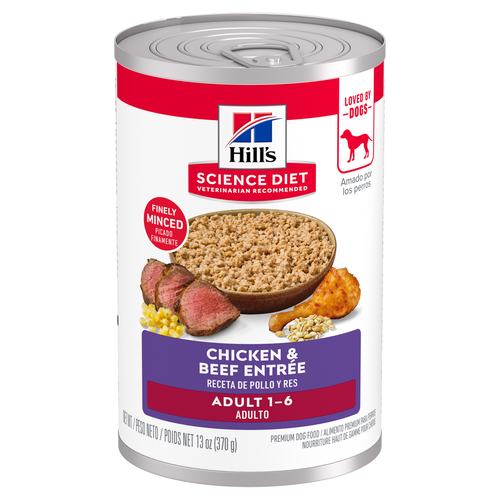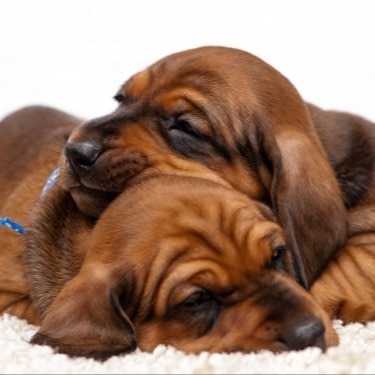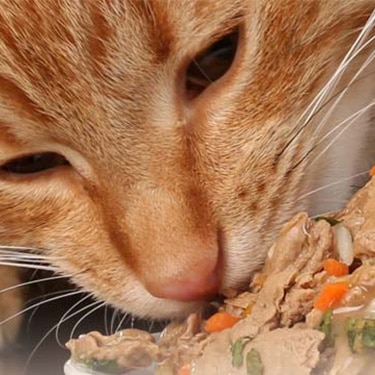
-
Find the right food for your petTake this quiz to see which food may be the best for your furry friend.Find the right food for your petTake this quiz to see which food may be the best for your furry friend.Featured products
 Hill's Science Diet Adult Chicken & Beef Entrée Dog Food
Hill's Science Diet Adult Chicken & Beef Entrée Dog FoodChicken & Beef Entrée in a delicious loaf with complete & balanced nutrition to help keep adult dogs active and healthy
Shop Now Adult Large Breed Chicken & Barley Recipe Dog Food
Adult Large Breed Chicken & Barley Recipe Dog FoodSupports healthy joints, lean muscle, and beautiful coat for large breed dogs
Shop Now Adult Chicken & Barley Recipe Dog Food
Adult Chicken & Barley Recipe Dog FoodSupports lean muscle and beautiful coat for adult dogs
Shop NowFeatured products Adult Tender No Corn, Wheat, Soy Chicken & Vegetables Stew Cat FoodShop Now
Adult Tender No Corn, Wheat, Soy Chicken & Vegetables Stew Cat FoodShop Now Senior Vitality Adult 7+ Tuna & Vegetables Stew
Senior Vitality Adult 7+ Tuna & Vegetables StewImproves Everyday Ability to Get Up & Go
Shop Now Adult Turkey & Liver Entrée Cat Food
Adult Turkey & Liver Entrée Cat FoodPrecisely balanced nutrition with the delicious taste of minced turkey & liver to help fuel the energy needs of cats during the prime of their life
Shop Now -
Dog
- Dog Tips & Articles
-
Health Category
- Weight
- Food & Environmental Sensitivities
- Urinary
- Digestive
- Joint
- Kidney
-
Life Stage
- Puppy Nutrition
- Adult Nutrition
- Senior Nutrition
Cat- Cat Tips & Articles
-
Health Category
- Weight
- Skin & Food Sensitivities
- Urinary
- Digestive
- Kidney
-
Life Stage
- Kitten Nutrition
- Adult Nutrition
Featured articles The Science Behind Our Love for Pets
The Science Behind Our Love for PetsLearn the scientific reasons why we have such strong connections with our pets, and what science says about the love between humans and our furry friends.
Read More What Is Littermate Syndrome? Pet Adoption Guide
What Is Littermate Syndrome? Pet Adoption GuideLearn more about littermate syndrome in dogs and cats and how to successfully navigate adoption and early socialization processes.
Read More How to Properly Mix Wet & Dry Pet Foods
How to Properly Mix Wet & Dry Pet FoodsAn Orange cat eating from a bowl filled with mixed food
Read More -


You know your dog benefits from regular bathing and brushing to maintain skin and coat health. But did you know cleaning your dog's paws is another important part of their grooming routine? Paw pads provide cushioning to help protect your dog's bones and joints from shock; create a barrier against hot, cold and rough surfaces; and protect paw tissue from harm.
But what's the best way to clean dog paws after a walk or other adventure? Here's a step-by-step guide on how to clean dog paws to keep them (and your home) free of muck, grime and debris.
First, Check In With Your Pup
Dogs' characteristics and sensitivities are as unique as their paw prints. As with any general grooming guideline, let your dog set the pace and adjust as needed to ensure they're comfortable. If your pup doesn't like their feet touched, don't dive right into paw cleaning. Start by touching their paws when you're hanging out together, gently lifting them or holding them in your hands. Reward them with a treat, and never force the issue.
It may take some dogs weeks of practice before they're comfortable enough to let you clean their paws — and that's OK. Some dogs are sensitive about their feet being touched and may never be a good candidate for paw cleaning. That's OK, too!

Your Guide to How to Clean Dog Paws
If your dog allows you to touch their paws, you're ready to get started. Here's the best way to clean dog paws after a walk or other outdoor romp in five simple steps.
1. Find a Comfortable Position
In general, big dogs do best lying down. If you have a small dog, try holding them on your lap or a helper's lap with your pup's feet facing you. Experiment with different positions to see what works best for your dog.
2. Check Their Fur and Remove Debris
Some breeds, like poodles and poodle mixes, have curly fur that can form tight mats between the pads on the bottom of their feet. Fur can even get tangled around the toenails if your dog isn't groomed regularly. Other breeds, like golden retrievers, don't have curly fur, but the fur between their toes can easily collect mud and snow.
Before washing, check your dog's paws and surrounding fur for items like cockleburs and acorn shells (two common suspects). If you find something on or near their paw pads, gently remove it. If it doesn't disentangle easily, or if your dog's fur is matted or otherwise in the way, ask your groomer or veterinarian for help.
3. Wash and Rinse
Soak a soft, clean cloth in lukewarm water. Gently wipe your dog's feet, getting between the toes to wipe away dirt and residue. Avoid scrubbing or tugging. Some people prefer to use dog cleansing wipes or a soft-bristled brush. If their feet are especially dirty (e.g., they stepped in something smelly), add a couple of drops of mild dog shampoo to your cloth or brush before wiping. Rinse thoroughly with lukewarm water.
4. Gently Dry
Gently squeeze each paw with a clean, dry towel to remove excess moisture. Excessive rubbing between the toes can cause irritation, so go easy!
5. Trim the Nails if Needed
You may want to trim your dog's nails and dewclaws — the extra nails on the sides of their paws — if they seem particularly long or sharp. In active dogs, the nails on the back feet often require less frequent trimming than those on the front feet. (When dogs run, they tend to push off from the hind limbs, gradually wearing the nails down.) If you're uncomfortable trimming your dog's toenails, ask a professional groomer or vet to do this at your pup's next appointment.



Tasty Tips
How Often to Clean Your Pup's Paws
There aren't specific guidelines for how often to clean your dog's paws. The ideal schedule depends on your dog's activity level and the season (harsh summers and winters can be tough on pets' paws). If you frequently take your dog hiking, for example, you may need to wash their paws after every trip to the trails. On the other hand, a dog who spends most of their time indoors, sticking to light neighborhood walks, might only need a cleaning when their paws get visibly dirty or wet.
Check your dog's feet regularly, such as after each big outing or at least once a week, and adjust your paw-cleaning schedule to fit their lifestyle and needs.

"Caring for your pup's paws helps keep muck and debris out of your home and reduces the risk of infections and irritation, promoting good health from head to toe."

Another Way to Say 'I Care'
Cleaning your dog's feet is just one small aspect of being a dog parent, but it all adds up. Caring for your pup's paws helps keep muck and debris out of your home and reduces the risk of infections and irritation, promoting good health from head to toe. It's also a great opportunity to build your bond and remind your dog you'll always be there to take care of them.


Dr. Karen Louis owns her low stress veterinary clinic near St. Louis. When she's not helping dogs and cats live their best lives, she maintains her blog, VetChick.com, and is an award winning nature photographer.
Related products

Supports lean muscle and beautiful coat for adult dogs

Supports healthy joints, lean muscle, and beautiful coat for large breed dogs

Chicken & Barley Entrée in a delicious loaf with great taste and precisely balanced nutrition to support 5 essential building blocks for lifelong health

Chicken & Beef Entrée in a delicious loaf with complete & balanced nutrition to help keep adult dogs active and healthy
Related articles

Wondering where can I buy a dog? Consider adoption and explore the pros and cons of adopting a dog from a breeder versus an animal shelter.

Discover how the field of dog science is giving us more and more insights into the inner workings of our furry best friends.

Your dog's coat and skin are a big part of your dog's overall health. Ensure you keep your dog's coat healthy, by following these simple tips.

Learn how to help keep your dog's immune system in tip-top shape, including nutritional immune system support for dogs and other strategies.

Put your dog on a diet without them knowing
Our low calorie formula helps you control your dog's weight. It's packed with high-quality protein for building lean muscles, and made with purposeful ingredients for a flavorful, nutritious meal. Clinically proven antioxidants, Vitamin C+E, help promote a healthy immune system.
Put your dog on a diet without them knowing
Our low calorie formula helps you control your dog's weight. It's packed with high-quality protein for building lean muscles, and made with purposeful ingredients for a flavorful, nutritious meal. Clinically proven antioxidants, Vitamin C+E, help promote a healthy immune system.

